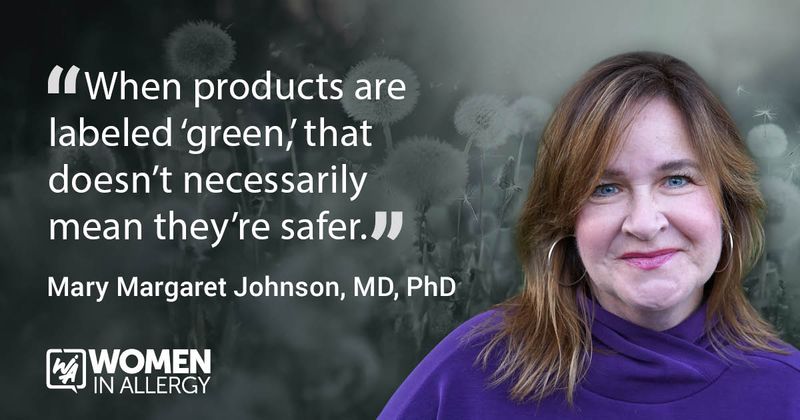Women may face greater allergy, respiratory risks from household cleaning product use
Key takeaways:
- Women may be more often exposed to cleaning product hazards than men, which can pose risk to respiratory health and cause allergic reactions.
- The disparity exists in home and occupational settings.
Women traditionally spend significantly more time than men completing housework such as cooking and cleaning, putting them at risk for higher exposures to harmful agents that are known to cause respiratory and allergic issues, experts said.
On average, women in the United States spend almost 4.5 hours per day caring for their households, whereas men spend roughly about 2.8 hours a day, according to a study published in The Lancet Public Health. That’s almost double the amount, raising the idea that women not only face an unequal distribution of work, but their corresponding health risks as well.

To understand the hazards household chores may pose to women, Healio spoke with experts on the risks associated with cleaning products as part of a two-part series, the second of which will review risks associated with cooking exposures.
Cleaning hazards
It is well-known that exposure to household cleaning products can exacerbate asthma symptoms.
For instance, as Healio previously reported, a study published last year in The Journal of Allergy and Clinical Immunology: In Practice showed that uncontrolled asthma was associated with weekly use of disinfectant and cleaning products. Researchers found the greatest risks for current asthma associated with disinfectant wipes used 1 to 3 days a week (OR = 1.46; 95% CI, 1.26-1.68) and 4 to 7 days a week (OR = 1.89; 95% CI, 1.51-2.37); as well as sprays (OR = 1.52; 95% CI, 1.31-1.77), irritants (OR = 1.69; 95% CI, 1.42-2.01) and “green” products (1.48; 95% CI, 1.25-1.75) used 4 to 7 days a week. Results showed similar doses-response trends for uncontrolled asthma.
“It is now known that frequent exposure to cleaning products, whether used in the workplace or during household cleaning, can cause asthma and, in asthmatic individuals, lead to more frequent symptoms and more difficult-to-control asthma,” Orianne Dumas, PhD, CR, HDR, occupational and respiratory epidemiologist from the Center for Research in Epidemiology and Population Health, Integrative Respiratory Epidemiology team in Villejuif, France, who served as a researcher on that study and many others on this topic, told Healio.

These impacts can even extend to unborn offspring. A study published this year in The Journal of Allergy and Clinical Immunology showed pregnant women who were exposed to cleaning products were more likely to have offspring with asthma.
Specifically, children of mothers whose exposure began before conception and continued into pregnancy had increased likelihood of childhood asthma (OR = 1.56; 95% CI, 1.05-2.31), childhood asthma with nasal allergies (OR = 1.77; 95% CI, 1.13-2.77) and childhood wheeze and/or asthma (OR = 1.71; 95% CI, 1.19-2.44).
“Recent studies have suggested that passive exposure to cleaning products by children at home during the first years of life, or exposure in-utero due to use of cleaning products during pregnancy, may also be associated with increased risk of respiratory symptoms such as wheezing in children, but the impact of this exposure on asthma development during childhood needs to be further studied,” Dumas said.
According to the American Lung Association, many cleaning products release hazardous chemicals, including volatile organic compounds, or VOCs. These and other chemicals can exacerbate chronic respiratory issues and trigger allergic reactions. Some examples of these include air fresheners, aerosol spray products, detergents, oven cleaners and even products marketed to be “green.”
“It is known that some of these substances, or the pollutants generated during the use of these products, can have a sensitizing effect (causing allergic reactions) or be irritating to the respiratory tract,” Dumas said. “The application mode may modulate the health effects. Using cleaning sprays increases asthma risk because this application mode generates particles in the air and facilitates their penetration into the lower respiratory tract.”
The frequency of use has a significant effect on respiratory health, with weekly use of the products more likely to carry a deleterious impact, Dumas noted.
“The risk of asthma and asthma-related symptoms is further increased when cleaning products are used at higher frequency (eg, daily or almost daily) and when a higher number of products is used,” she said.
Even for otherwise healthy women, frequent use of cleaning sprays at home can increase risk for new-onset asthma.
“Anyone who’s inhaling or exposed to the chemicals would be at increased risk,” Mary Margaret Johnson, MD, PhD, principal research scientist at Harvard T.H. Chan School of Public Health, told Healio. “Occupational exposure to cleaning and disinfectant products are linked to asthma and rhinitis and exposure is linked to asthma onset.”
Gender disparity
Research has shown that women already have increased odds of experiencing an asthma attack compared with men while also experiencing more prevalent and severe symptoms.
Specifically, studies have shown that men and women experience different levels of asthma severity, potentially due to immunological and hormonal factors. For example, research from Muiser and colleagues found that women with asthma had worse disease control and higher risks for exacerbations compared with men.
Given these increased asthma risks inherent to women, the fact they may be more exposed to household hazards can compound these risks.
“All studies ... show that women use cleaning products more frequently than men,” Dumas said, adding that these studies were conducted in France and other European countries. “They are thus more exposed to this hazard and potential health consequences.”
The occupational hazard of cleaning also appears to pose a stronger risk to women. In a study examining asthma effects in cleaning staff conducted by Lee and colleagues, women more frequently reported chemical exposure symptoms than their male colleagues (46% vs. 25.4%; adjusted OR = 26.3; 95% CI, 1.27-5.46).
Also, an analysis of the Community Respiratory Health Survey conducted by Svanes and colleagues found a significant correlation between women who cleaned at home or at work and a decline in lung function vs. those who did not, although this association did not occur among men. They also found that the number of men regularly using cleaning products at home was lower compared with women (46.5% vs. 85.1%).
“In adults, asthma is more common in women than in men and household-related exposure may partly explain this difference, along with other sex-related factors (eg, hormonal exposures) and environments (eg, occupational exposures that may differ in men and women),” Dumas said.
Guidance, recommendations
Choosing safer cleaning products and practices can mitigate the harmful effects of frequent cleaning product use, Dumas and Johnson said.
“Overall, it should be recommended to limit as much as possible the use of cleaning products (eg, these products should not be used on a daily basis) and to clean with water and soap or with microfiber cloths, when possible,” Dumas said. “The use of sprays should be avoided.”
However, Dumas cautioned that homemade products should be made carefully. Essential oils should be avoided as they can contain sensitizing agents and secondary pollutants. Air ventilation should also be prioritized during cleaning.
“You could use air purifiers or a mask, but ideally you just wouldn't use those substances,” Johnson said. “If they get on your skin, wash your skin right away.”
The American Lung Association cautions against products with a “green” label, stating that manufacturers are not obligated to list all their ingredients in accordance with U.S. law. Green labels might also focus generally on environmental impact and not the human health impact.
“When products are labeled ‘green,’ that doesn’t necessarily mean they’re safer,” Johnson said.
Implementing stricter regulations that would prevent companies from omitting certain ingredients from their labels, or using misleading words on their products, could also cause significant change.
“I think physicians can help push for stronger regulations and educate their patients,” Johnson said.
Experts further urge medical professionals to focus on educating their patients on the dangers of household cleaning products.
“They should be educating all women probably starting with pregnant women coming in, to be careful with what they’re using,” Johnson said. “Physicians have a right to have a responsibility to educate women concerning their own health and the health of their children.”
In addition to pregnant women, women with asthma are another important group to counsel on this matter.
“We recommend physicians advise their asthmatic patients to reduce as much as possible the use of at-home cleaning products in order to improve and maintain their asthma control,” Dumas said.
References:
- Cleaning supplies and household chemicals. https://www.lung.org/clean-air/indoor-air/indoor-air-pollutants/cleaning-supplies-household-chem. Updated July 2024. Accessed July 23, 2024.
- Cooper L, et al. Abstract 072. Presented at: AAAAI Annual Meeting; Feb. 23-26, 2024; Washington, D.C.
- Ervin J, et al. Lancet Public Health. 2022;doi:10.1016/S2468-2667(22)00160-8.
- Lee SJ, et al. Am J Ind Med. 2021;doi:10.1002/ajim.23246.
- Muiser S, et al. Sex differences in asthma control, lung function and exacerbations: The ATLANTIS study. Presented at: American Thoracic Society International Conference; May 19-24, 2023; Washington, D.C.
- Pacheco Da Silva E, et al. Indoor Air. 2022;doi:10.1111/ina.13078.
- Pacheco Da Silva E, et al. J Allergy Clin Immunol Pract. 2023;doi:10.1016/j.jaip.2023.12.029.
- Svanes Ø, et al. Am J Respir Crit Care Med. 2018;doi:10.1164/rccm.201706-1311OC.
For more information:
Orianne Dumas PhD, CR, HDR, can be reached at orianne.dumas@inserm.fr.
Mary Margaret Johnson, MD, PhD, can be reached at mjohnson@hsph.harvard.edu.

